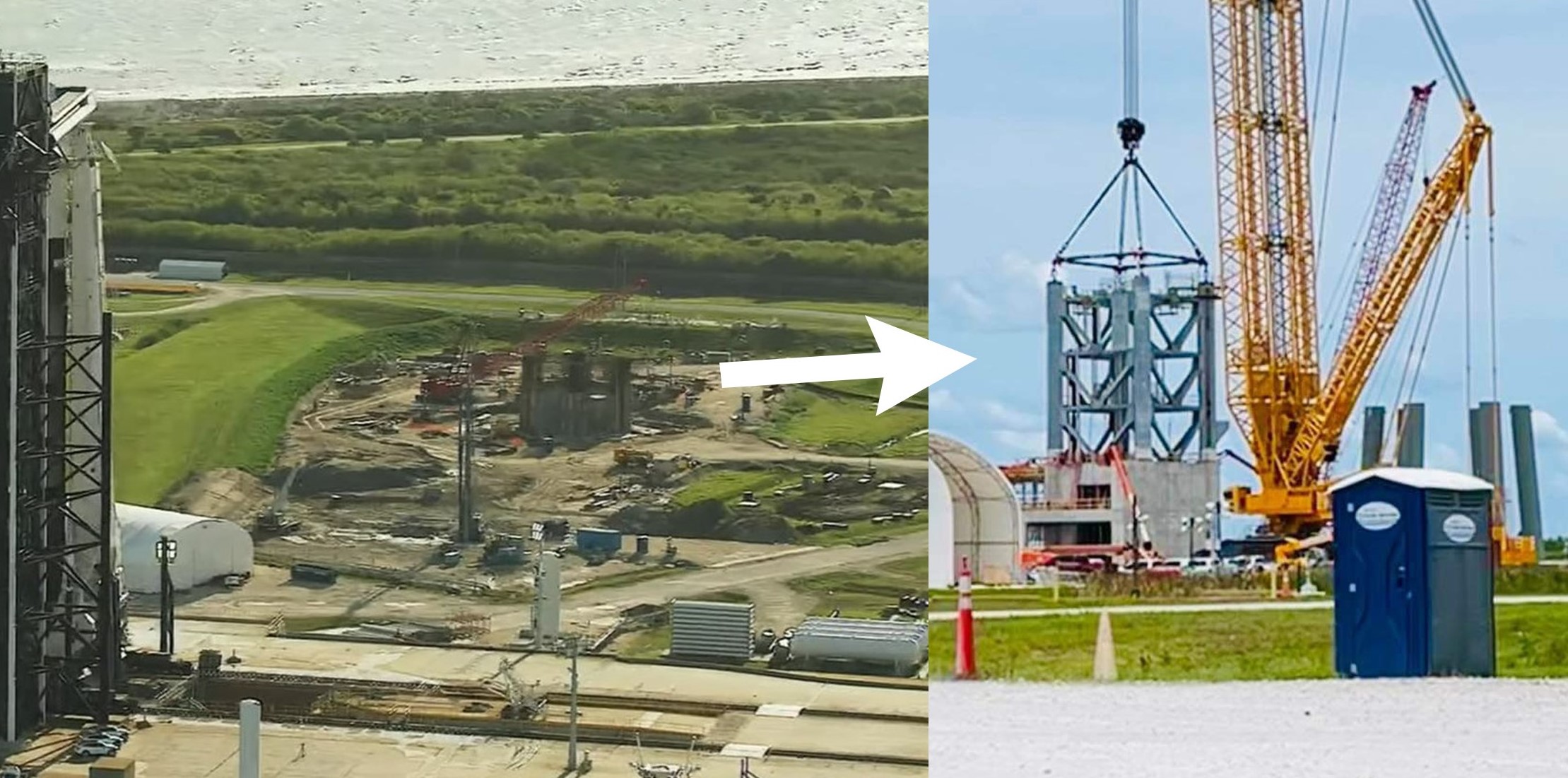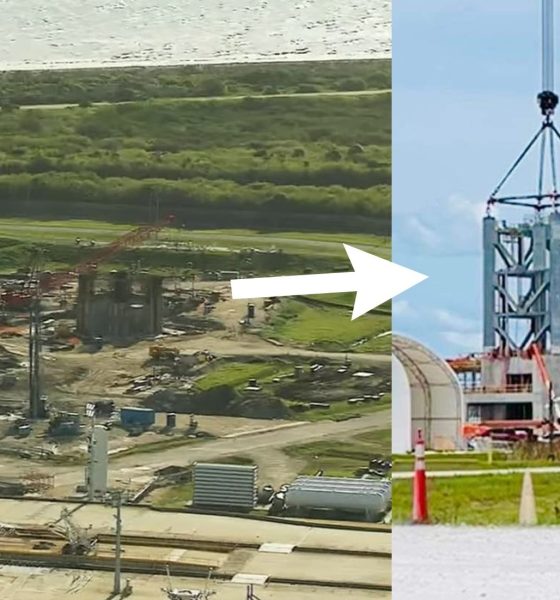

News
SpaceX begins stacking Florida Starship launch tower
SpaceX has begun stacking Starship’s first Florida launch tower.
Less than half a year after the company restarted work on a Starship launch pad located just a few hundred feet away from existing Falcon launch facilities at NASA’s Kennedy Space Center (KSC) LC-39A pad, a massive new launch tower has begun to take shape. Once it reaches its final height, that tower will become the second tallest rocket-related structure (excluding lightning towers) on the East Coast, only beaten by NASA’s iconic Vehicle Assembly Building (VAB).
It could reach that height far sooner than later.
For Starship’s Pad 39A facilities, SpaceX faces the unique challenge of organizing a major construction operation at one of the busiest and most important active launch sites in the US. In just the first half of 2022, LC-39A is on track to support 10 Falcon 9 launches, imposing unique constraints on adjacent Starship pad construction. In a partial response to those challenges, as previously discussed on Teslarati, SpaceX has taken lessons learned from Starbase, Texas and optimized the assembly process of a number of pad components to limit the amount of work that will need to be done at the pad itself.
For the first launch tower, SpaceX and its contractors moved exceptionally quickly and took just over three months after work on the first prefabricated section began to stack the structure to its full height of ~146 meters (~480 ft). Each of the nine sections was essentially bare, however, reducing the amount of pre-stack work but drastically complicating and increasing the amount of post-stack work required to turn the tower into something useful. For Florida’s first Starship launch tower, SpaceX has spent more than three months assembling and meticulously outfitting the first six of nine prefabricated tower sections before the first stack.
The sections SpaceX began stacking on June 21st already have a variety of railings, elevator shafts, doorways, walkways, hardpoints, plumbing, and more preinstalled. While each section and all abbreviated plumbing and hardware will need to be connected after each stack, that process should be far easier and faster than the methods SpaceX used in South Texas. Offsite, SpaceX is also making excellent progress assembing the pad’s donut-like orbital launch mount and parts of the three giant arms that will eventually attach to Starship’s first Florida launch tower – two for lifting and catching rockets and a third for stabilizing and fueling Starship.
Much like the tower segments, there’s a good chance that those other Floridan components will be closer to completion than their Texas siblings were when they eventually head to the launch pad for installation. Additionally, if SpaceX’s experience in Texas is representative, Starship’s first Florida launch tower could reach its full height just a few months from now.
For the tower to be truly complete, SpaceX will need to finish and install three arms, and connect one of those arms to ground supplies of Starship gases and propellant located at Pad 39A. Because 39A has never needed methane, Starship’s fuel of choice, that step will also require the installation and activation of a new tank farm and plumbing capable of storing, rapidly ‘subcooling,’ and distributing at least a thousand tons (~2.2M lb) of liquid methane (LCH4). Starbase Florida is making great progress but a large amount of work still stands between SpaceX and launch readiness.

News
Tesla FSD fleet is nearing 7 billion total miles, including 2.5 billion city miles
As can be seen on Tesla’s official FSD webpage, vehicles equipped with the system have now navigated over 6.99 billion miles.

Tesla’s Full Self-Driving (Supervised) fleet is closing in on almost 7 billion total miles driven, as per data posted by the company on its official FSD webpage.
These figures hint at the massive scale of data fueling Tesla’s rapid FSD improvements, which have been quite notable as of late.
FSD mileage milestones
As can be seen on Tesla’s official FSD webpage, vehicles equipped with the system have now navigated over 6.99 billion miles. Tesla owner and avid FSD tester Whole Mars Catalog also shared a screenshot indicating that from the nearly 7 billion miles traveled by the FSD fleet, more than 2.5 billion miles were driven inside cities.
City miles are particularly valuable for complex urban scenarios like unprotected turns, pedestrian interactions, and traffic lights. This is also the difference-maker for FSD, as only complex solutions, such as Waymo’s self-driving taxis, operate similarly on inner-city streets. And even then, incidents such as the San Francisco blackouts have proven challenging for sensor-rich vehicles like Waymos.
Tesla’s data edge
Tesla has a number of advantages in the autonomous vehicle sector, one of which is the size of its fleet and the number of vehicles training FSD on real-world roads. Tesla’s nearly 7 billion FSD miles then allow the company to roll out updates that make its vehicles behave like they are being driven by experienced drivers, even if they are operating on their own.
So notable are Tesla’s improvements to FSD that NVIDIA Director of Robotics Jim Fan, after experiencing FSD v14, noted that the system is the first AI that passes what he described as a “Physical Turing Test.”
“Despite knowing exactly how robot learning works, I still find it magical watching the steering wheel turn by itself. First it feels surreal, next it becomes routine. Then, like the smartphone, taking it away actively hurts. This is how humanity gets rewired and glued to god-like technologies,” Fan wrote in a post on X.
News
Tesla starts showing how FSD will change lives in Europe
Local officials tested the system on narrow country roads and were impressed by FSD’s smooth, human-like driving, with some calling the service a game-changer for everyday life in areas that are far from urban centers.

Tesla has launched Europe’s first public shuttle service using Full Self-Driving (Supervised) in the rural Eifelkreis Bitburg-Prüm region of Germany, demonstrating how the technology can restore independence and mobility for people who struggle with limited transport options.
Local officials tested the system on narrow country roads and were impressed by FSD’s smooth, human-like driving, with some calling the service a game-changer for everyday life in areas that are far from urban centers.
Officials see real impact on rural residents
Arzfeld Mayor Johannes Kuhl and District Administrator Andreas Kruppert personally tested the Tesla shuttle service. This allowed them to see just how well FSD navigated winding lanes and rural roads confidently. Kruppert said, “Autonomous driving sounds like science fiction to many, but we simply see here that it works totally well in rural regions too.” Kuhl, for his part, also noted that FSD “feels like a very experienced driver.”
The pilot complements the area’s “Citizen Bus” program, which provides on-demand rides for elderly residents who can no longer drive themselves. Tesla Europe shared a video of a demonstration of the service, highlighting how FSD gives people their freedom back, even in places where public transport is not as prevalent.
What the Ministry for Economic Affairs and Transport says
Rhineland-Palatinate’s Minister Daniela Schmitt supported the project, praising the collaboration that made this “first of its kind in Europe” possible. As per the ministry, the rural rollout for the service shows FSD’s potential beyond major cities, and it delivers tangible benefits like grocery runs, doctor visits, and social connections for isolated residents.
“Reliable and flexible mobility is especially vital in rural areas. With the launch of a shuttle service using self-driving vehicles (FSD supervised) by Tesla in the Eifelkreis Bitburg-Prüm, an innovative pilot project is now getting underway that complements local community bus services. It is the first project of its kind in Europe.
“The result is a real gain for rural mobility: greater accessibility, more flexibility and tangible benefits for everyday life. A strong signal for innovation, cooperation and future-oriented mobility beyond urban centers,” the ministry wrote in a LinkedIn post.
News
Tesla China quietly posts Robotaxi-related job listing
Tesla China is currently seeking a Low Voltage Electrical Engineer to work on circuit board design for the company’s autonomous vehicles.

Tesla has posted a new job listing in Shanghai explicitly tied to its Robotaxi program, fueling speculation that the company is preparing to launch its dedicated autonomous ride-hailing service in China.
As noted in the listing, Tesla China is currently seeking a Low Voltage Electrical Engineer to work on circuit board design for the company’s autonomous vehicles.
Robotaxi-specific role
The listing, which was shared on social media platform X by industry watcher @tslaming, suggested that Tesla China is looking to fill the role urgently. The job listing itself specifically mentions that the person hired for the role will be working on the Low Voltage Hardware team, which would design the circuit boards that would serve as the nervous system of the Robotaxi.
Key tasks for the role, as indicated in the job listing, include collaboration with PCB layout, firmware, mechanical, program management, and validation teams, among other responsibilities. The role is based in Shanghai.
China Robotaxi launch
China represents a massive potential market for robotaxis, with its dense urban centers and supportive policies in select cities. Tesla has limited permission to roll out FSD in the country, though despite this, its vehicles have been hailed as among the best in the market when it comes to autonomous features. So far, at least, it appears that China supports Tesla’s FSD and Robotaxi rollout.
This was hinted at in November, when Tesla brought the Cybercab to the 8th China International Import Expo (CIIE) in Shanghai, marking the first time that the autonomous two-seater was brought to the Asia-Pacific region. The vehicle, despite not having a release date in China, received a significant amount of interest among the event’s attendees.








